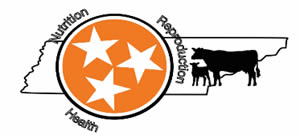
There are over 5 million replacement heifers entering the US beef herd annually. The development of these females is one of the most critical components of cow-calf production. One of the most important factors in early reproductive success is nutrition. Replacement heifers must be supplied with enough energy to support both somatic development and reproductive function. Strictly monitoring the rate of gain is essential in the development of heifers. By maintaining a balanced diet, producers can encourage essential reproductive development while at the same time preventing over- and under-conditioning (Garret, 1988; Larson, 2007). Research has indicated that the rate of growth during heifer development is not as important as reaching a target body weight before the breeding season; however, heifers that conceive earlier in the breeding season have longer to recover after calving and a better chance to rebreed the following year. The rate of growth during heifer development may impact molecular mechanisms of reproductive efficiency (Cardoso et al., 2014) and the overall economics of heifer development. Therefore, our hypothesis was that increased growth rate diets will trigger a different inflammatory response in developing beef heifers compared with more moderate growth trajectories.
In a current study conducted in our lab at the University of Tennessee, weaned Angus-crossbred heifers (n=48) were randomly assigned to one of 3 supplemental treatments: 1) control (CON); targeted 1.5 lbs./day for the entire treatment period (120 d), 2) fast then slow (F/S); targeted 2.75 lbs./day for the first 57 d then 0.25 lbs./day for the last 63 d, and 3) slow then fast (S/F); targeted 0.25 lbs./day for the first 57 d then 2.75 lbs./day for the last 63 d. Grain supplements comprised of 75% dry distillers’ grain and 25% corn. Heifer BW was not different at the beginning (average BW 637.9 lbs) or end (average BW 830.8 lbs) of the trail. These data confirm that the developmental programs were all successful even with the differential growth rates. The total amount of supplement consumed was the highest in the CON heifers (706.2 lbs) and the S/F group was higher (612.7 lbs) than the F/S (583.7 lbs). Since all heifers were provided the same supplement at a cost of $300 per ton the linear growth heifers (CON) cost the most to develop. To further elucidate the impacts of growth rate analysis of the Gain:Feed (G:F) ratio was conducted. The overall G:F was the lowest for the CON heifers (0.077 lbs of gain per lbs of feed), the S/F heifers (0.08 ± 0.001 lbs of gain per lbs of feed) were also lower than the F/S heifers (0.084 lbs of gain per lbs of feed). Interestingly, even with increased consumption and altered G:F the cost per pound of gain only tended (P = 0.07) to be impacted by growth rate ranging from $2.80 to $2.26 per lb. While this study did not result in developmental differences, it did have economic impacts to the cost for replacement heifers. This may also add weight to the impacts of plane of nutrition during development that could impact reproductive outcomes. Immediately following weaning may be a period of time when heifers can be developed with limited supplementation without long term implications to productivity and reproductive performance.
Download a copy of this article as a pdf file.

